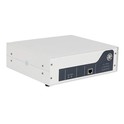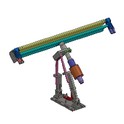Can a 6000w ultrasonic generator be used for emulsification?
As a supplier of 6000W ultrasonic generators, I often encounter questions from customers about the application of our products, especially regarding their suitability for emulsification. In this blog post, I will delve into the topic to provide a comprehensive answer and shed light on the potential of a 6000W ultrasonic generator in emulsification processes.
Understanding Emulsification
Emulsification is a process of dispersing one immiscible liquid into another in the form of droplets, creating a stable emulsion. This process is widely used in various industries, including food, cosmetics, pharmaceuticals, and chemical engineering. Emulsions can be classified into two main types: oil - in - water (O/W) and water - in - oil (W/O). The stability and quality of an emulsion depend on several factors, such as the droplet size, interfacial tension, and the presence of emulsifiers.
How Ultrasonic Generators Work in Emulsification
Ultrasonic generators produce high - frequency sound waves that create cavitation bubbles in the liquid medium. Cavitation is the formation, growth, and sudden collapse of these bubbles. When the bubbles collapse, they generate intense local pressure and shear forces. These forces are strong enough to break down the larger droplets of the dispersed phase into smaller ones, reducing the droplet size and increasing the surface area of the interface between the two immiscible liquids. As a result, the interfacial tension is reduced, and a more stable emulsion can be formed.
Advantages of Using Ultrasonic Generators for Emulsification
- Smaller Droplet Size: Ultrasonic emulsification can produce much smaller droplet sizes compared to traditional emulsification methods, such as mechanical stirring. Smaller droplets lead to a more stable emulsion with better physical and chemical properties.
- Uniformity: Ultrasonic waves can create a more uniform distribution of droplets in the continuous phase, improving the homogeneity of the emulsion.
- Reduced Emulsifier Usage: The intense shear forces generated by ultrasonic cavitation can reduce the need for large amounts of emulsifiers, which is beneficial for industries where minimizing the use of additives is desired.
- Faster Process: Ultrasonic emulsification is generally a faster process than traditional methods, saving time and increasing production efficiency.
Can a 6000W Ultrasonic Generator Be Used for Emulsification?
The short answer is yes. A 6000W ultrasonic generator has a relatively high power output, which means it can generate stronger cavitation effects and more intense shear forces compared to lower - power ultrasonic generators. This high power is particularly useful for emulsifying large volumes of liquids or for emulsifying substances with high viscosity or difficult - to - emulsify components.
However, the suitability of a 6000W ultrasonic generator for a specific emulsification task also depends on other factors:


- Liquid Volume: For small - scale emulsification, a 6000W generator may be too powerful and could lead to over - emulsification or even damage to the sample. In such cases, a lower - power 1000W Ultrasonic Generator or 2000W Ultrasonic Generator might be more appropriate. On the other hand, for large - scale industrial emulsification processes, the 6000W generator can provide the necessary power to handle large volumes of liquid efficiently.
- Viscosity of the Liquid: High - viscosity liquids require more energy to break down the droplets. A 6000W ultrasonic generator can supply the additional power needed to emulsify these viscous substances effectively.
- Temperature Sensitivity: The high - power operation of a 6000W ultrasonic generator may generate a significant amount of heat. If the substances being emulsified are temperature - sensitive, proper cooling measures need to be implemented to prevent thermal degradation of the products.
Our 6000W Ultrasonic Generator for Emulsification
Our 6000W Ultrasonic Generator is designed with advanced technology to ensure stable and efficient operation in emulsification processes. It features:
- Adjustable Power Output: The power output of the generator can be adjusted according to the specific requirements of the emulsification task, allowing for greater flexibility.
- Precise Frequency Control: Precise control of the ultrasonic frequency ensures optimal cavitation effects and consistent emulsification results.
- Robust Design: Our generator is built with high - quality components to withstand the rigors of industrial use, providing long - term reliability.
Case Studies
In the food industry, a company was struggling to create a stable oil - in - water emulsion for a new salad dressing product. They initially used a traditional mechanical stirrer but found that the emulsion had a large droplet size and was not stable over time. After switching to our 6000W ultrasonic generator, they were able to achieve a much finer and more stable emulsion. The smaller droplet size improved the texture and appearance of the salad dressing, and the product's shelf - life was significantly extended.
In the cosmetic industry, a manufacturer of skin creams was looking to improve the quality of their emulsions. By using our 6000W ultrasonic generator, they were able to reduce the droplet size of the oil phase in their water - in - oil creams. This led to a smoother and more luxurious texture, and the creams were better absorbed by the skin, resulting in increased customer satisfaction.
Conclusion
A 6000W ultrasonic generator is a powerful tool for emulsification, offering many advantages over traditional methods. It can be used in a wide range of industries to produce high - quality emulsions with smaller droplet sizes, better uniformity, and reduced emulsifier usage. However, it is important to consider the specific requirements of the emulsification task, such as the liquid volume, viscosity, and temperature sensitivity, when choosing the appropriate power level.
If you are interested in learning more about our 6000W ultrasonic generator or have any questions about its application in your emulsification process, please feel free to contact us for a detailed discussion. We are committed to providing you with the best solutions for your emulsification needs.
References
- Mason, T. J., Paniwnyk, L., & Lorimer, J. P. (1996). The uses of ultrasound in food technology. Trends in Food Science & Technology, 7(4), 139 - 147.
- McClements, D. J. (2005). Food emulsions: principles, practice, and techniques. CRC press.
- Suslick, K. S., & Flannigan, D. J. (2008). Ultrasound: technology, applications, and uses. Annual Review of Materials Research, 38(1), 295 - 326.






